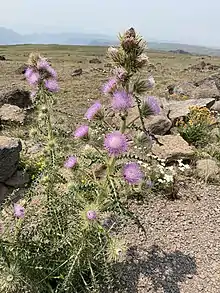| Cirsium peckii | |
|---|---|
 | |
| Scientific classification | |
| Kingdom: | Plantae |
| Clade: | Tracheophytes |
| Clade: | Angiosperms |
| Clade: | Eudicots |
| Clade: | Asterids |
| Order: | Asterales |
| Family: | Asteraceae |
| Genus: | Cirsium |
| Species: | C. peckii |
| Binomial name | |
| Cirsium peckii | |
| Synonyms | |
| |
Cirsium peckii, the Steens Mountain thistle, is a very spiny and prickly perennial plant in the family Asteraceae that grows in the Great Basin of the western United States.[1]: 58
Growth pattern
It is a perennial plant that grows with a single nonbranching erect stem from 1 to 4 feet (0.30 to 1.22 m) tall, covered with sharp stiff hairs.
Leaves and stems
Leaves are lanceolate and deeply divided, with sharp, pointed, yellow needle-like teeth on the points of lobes, and are either hairless or have sparse hairs on the midrib. The lower leaves are 6 to 8 inches (15 to 20 cm) long.
Inflorescence and fruit
Light lavender heads of flowers are clustered at the base of the leaves along the upper part of the stem.
It flowers from June to August.[1]: 58
Range and habitat
It grows from 6,500 to 9,700 feet (2,000 to 3,000 m) on dry slopes and rocky places in sagebrush steppe communities of the Great Basin, to southern Oregon where it can be found on Steens Mountain.[1]: 58
Etymology
Morton Peck was a 20th-century professor of botany at Willamette University and author of A Manual of the Higher Plants of Oregon.[1]: 58